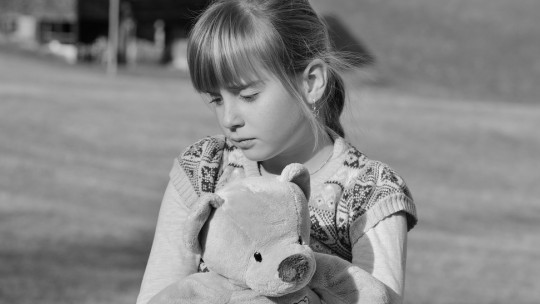
I am introverted or extroverted, stable or unstable, sensitive or insensitive, intuitive or rational. All these categories reflect aspects of personality which are widely used in psychology.
The personality we have will determine how we see the world and react to it. But the personal characteristics that are our own have not always been there in the same way, but rather We have been going through different stages of personality development until we become who we are, from childhood to our current situation and even to our future death.
Definition of personality
Personality is defined as a pattern of behavior, thought and emotion that is relatively stable over time and across the different situations we experience. This pattern explains how we perceive reality the judgments we make about it or the way we interact with the environment, being partly inherited and partly acquired and subsequently shaped through life experience.
Because it is born largely from the set of experiences that we live throughout our lives, it is considered that personality as such is not fully configured until adulthood, with a long process of development until it stabilizes (although it can be undergo subsequent variations, they are not frequent nor do they tend to be marked).
Evolution through the different life stages
To establish a chronology of the stages of personality development, it is interesting to start from the classification of the main life stages.
Starting from them as a reference, let’s see How does the psychological structure develop? of human beings.
1. The first moments
At the moment a baby is born we cannot consider it to have a marked personality, since the new individual has not had specific experiences that make it be, think or act in a certain way. However, it is true that as the days go by we see how the boy or girl has a tendency to behave in a certain way: For example, we can observe if he cries a lot or a little, how he feeds, or if he responds to touch with fear or curiosity.
These first features They are part of what is called temperament, which is part of the person’s innate constitution and which can subsequently be molded through learning. Temperament has a biological basis and comes mainly from the genetic inheritance of our ancestors. Being a component linked mainly to affectivity, it is a primordial component that will act as a basis for the construction of personality.
2. Childhood
As the subject grows, he or she gradually develops different cognitive and physical abilities that will allow him or her to grasp reality, begin to try to understand how the world works and how one’s own being can influence and participate in it.
This stage is characterized by acquisition of values, beliefs and norms from outside, in an initially imitative way and with few critical overtones. The personality begins to form as the characteristics of the temperament are confronted with reality, acquiring behavioral patterns and ways of seeing the world and forming the character.
In this stage self-esteem tends to be initially high due to the high level of attention that is usually provided to minors in the family environment. However, at the time of entering the school world it tends to decrease, because the family environment is left behind to enter an unknown one in which numerous points of view converge.
3. Puberty and adolescence
Adolescence, the point at which we go from being children to being adults, is a key stage in the formation of personality It is a complex life stage in which the organism is in a process of change, while expectations regarding the individual’s behavior increase and the individual begins to experience different aspects and realities.
It is a vital moment characterized by the need to differentiate oneself, and it is common for a rupture or separation to appear with respect to the adults in charge and a continuous questioning of everything that has been instilled until then
The number of environments in which the person participates increases, as well as the number of people with whom they interact, promoting hormonal changes and the increase in the capacity for abstraction typical of cognitive maturation, which will make them experience different roles that They will teach you what you like and what is expected of him or her. It is given a enhancing the search for social connection and the first relationships appear. The adolescent seeks his own identity as well as a feeling of belonging to the social environment, trying to insert himself as part of the community and the world.
At this stage, self-esteem tends to vary as a result of the insecurities and discoveries of adolescence. Through experimentation, the adolescent will try different ways of seeing life, staying and introjecting some aspects and varying others. He searches for his own identity, a search that over time crystallizes into a differentiated personality.
4. Adulthood
It is considered that it is from adolescence onwards that we can talk about personality itself, having already forged a relatively stable pattern of behavior, emotion and thought.
This personality will still vary throughout life but broadly speaking the structure will be similar unless some very relevant event happens for the subject that pushes him to make changes in his way of visualizing the world.
In relation to other life stages, self-esteem tends to rise and in general the adult’s self-concept tends to try to bring their real self closer to the ideal, so shyness decreases, if it has been raised previously. As a consequence, what others think of oneself is no longer so important, and activities can be carried out that in previous stages would be embarrassing.
5. Old age
Although in general the personality remains stable, reaching old age involves the progressive experience of situations such as the loss of skills, work activity and loved ones, which can greatly affect our way of relating to the world. A is registered tendency toward decreased extraversion and self-esteem
Two old theories about personality development
The elements written above reflect a general trend throughout the life stages. However, there are many authors who have established theories about how personality develops. Two of the best known, although also outdated, are Freud’s theory of psychosexual development and Erikson’s theory of psychosocial development, establishing each different stages of personality development
In any case, it must be taken into account that these proposals for personality development are based on a paradigm of meta-psychology that has been highly criticized for its speculative nature and impossible to test, which is why today they are not considered. scientifically valid, although historically they have had great influence.
Freud’s psychosexual development
For the founding father of psychoanalysis, the personality of the human being is shaped throughout life through various stages of personality development. The personality is structured in an id or drive part, a superego that censors said desires based on morality and an ego that mediates between said aspects.
With libido as a fundamental psychic energy, Freud’s theory considers that we are born only with our instinctual part, with the ego and superego being born over time as we introject social norms. Constant instinctual conflicts cause the body to use defense mechanisms in order to reduce the tension they produce, mechanisms that are often used and that allow us to explain personality traits and facets.
For Freud, we go through a series of stages in which we place our sources of pleasure and frustration in different areas of the body, expressing libido from them. These stages are progressively overcome, although there may be regressions or stagnations that produce fixations on certain behaviors and ways of seeing the world and personal relationships.
1. Oral stage
During the first year of life, the human being is immersed in what is known as the oral stage, in which we use our mouths to explore the world and get gratification from it. We nourish ourselves, bite and taste different objects through it. Thus, the mouth plays the role that the hands will later play, and that for Freud conditions psychosexual development at this stage of life.
2. Anal stage
After the oral stage and until around three years of age, the core of psychosexual interest becomes the anus, as it begins to control the sphincters and this provides an element of pleasure in being able to manage what it keeps inside itself and what it expels The child can defecate, which reduces internal tension, or retain feces voluntarily.
3. Phallic stage
Between three and six years of age the individual usually enters the phallic phase or stage. It is at this stage that there begins to be an interest in sexuality, focusing attention on genitality and the Oedipus complex, jealousy and regret appear.
4. Latency stage
From the age of seven and up to adolescence we can find that the expression of sexual energy does not find a physical correlate through which to express itself, due largely to the influence of the social and moral. Modesty appears and sexual impulses are reduced.
5. Genital stage
Typical of puberty and adolescence, this stage is accompanied by the physical, psychological and emotional changes typical of such a vital moment. Libido begins to express itself through genitalia, the desire for bonding and attachment appearing intensely and having sufficient capacity to carry out the expression of sexuality in both a symbolic and physical way.
Erikson’s psychosocial development
Another prominent author and one of the pioneers in proposing that personality develops from birth to death was Erik Erikson, who considered that the development of psychic configuration and personality They derive from the social nature of the human being or, in other words, social interaction.
For this author, Each life stage involves a series of conflicts and problems that the individual has to face until they are overcome, growing and strengthening their self as they are overcome and forging the way of seeing, thinking and acting in the world of each subject.
The different stages of personality development for Erikson are the following.
1. Basic Trust vs Distrust
The first of the crises that the human being must face throughout life appears at the moment of birth, being the basis from which the rest of the psychic structure will be configured. According to this theory, lasts until approximately eighteen months of age During this stage the individual must decide whether or not he is capable of trusting stimuli and people coming from outside or in the effects that his own actions have on the world.
That is, if you can feel comfortable in the presence, for example, of your parents and family members. Successfully overcoming this stage will mean that you are able to find a balance between trust and distrust in which trust prevails, which will allow you to establish secure relationships with other people while trusting yourself.
Thus, in this stage of Erikson’s development, as in the following ones, the objective is to reach a point of balance or adjustment in which autonomy fits well with the social life one leads, without harming or being harmed.
2. Autonomy vs Shame/Doubt
From overcoming the previous stage and up to three years of age, the individual will gradually develop their body and mind, learning to control and manage their body and their behavior based on both maturation and practice. of the information that comes to him from his parents, who teach him what he can and cannot do.
Over time, these circumstances will be internalized, and the child will carry out behavioral tests to verify the effects and consequences, little by little developing their autonomy. They seek to be guided by their own ideas. However, they also need limits, and there is a doubt about what they can or cannot do. The objective of this crisis is to achieve self-control and self-management of our own behavior so that we act adaptively.
3. Initiative vs Guilt
In the period of time between three and five years of age, the child begins to develop greater activity autonomously Their level of activity drives them to generate new behaviors and ways of relating to the world, giving rise to initiative.
However, the feedback from this initiative can generate feelings of guilt in the minor, if the consequences of experimenting are adverse. A balance is necessary that allows us to see our responsibility in our actions while being free.
4. Industriousness vs Inferiority
From the age of seven until adolescence, children continue to mature cognitively and learn how reality works. You need to act, do things, experiment If you fail to carry them out, feelings of inferiority and frustration may appear. The result of this stage of personality development is obtaining a feeling of competence. It is about being able to act in a balanced way, without giving up at the slightest obstacle but without setting unattainable expectations.
5. Identity Exploration vs. Identity Diffusion
Typical of adolescence, it is one of the crises best known to most people At this stage the main problem of the individual is to find his identity, discover who he is and what he wants. To do this, they tend to explore new options and separate themselves from what they have known until then. But the large number of variables involved or a restriction of exploration can mean that identity does not develop freely, producing multiple personality problems.
6. Privacy vs Isolation
From the ages of twenty to forty, the main conflict that human beings must face in the development of their personality is the search for personal relationships and an appropriate and committed way of bonding. It seeks the ability that in the interrelationships feelings of security and trust can be given
7. Generativity vs Stagnation
From forty to approximately sixty years of age, a person tends to dedicate themselves to the protection of their loved ones and to the search and maintenance of a future for the next generations.
At this stage the main conflict It is based on the idea of feeling useful and productive, feeling that their efforts have meaning. However, it is necessary to keep in mind that a balance must be sought between activity and stillness, or there is a risk of either not being able to achieve everything or not being able to produce or feel useful.
8. Ego Integrity vs Despair
The last of the vital crises occurs in old age When the moment arrives when productivity is reduced or ceases to exist, the subject begins to assess whether his or her existence has had meaning. Accepting the life we have lived and seeing it as valid is the fundamental thing of this stage, which culminates at the moment of death.








